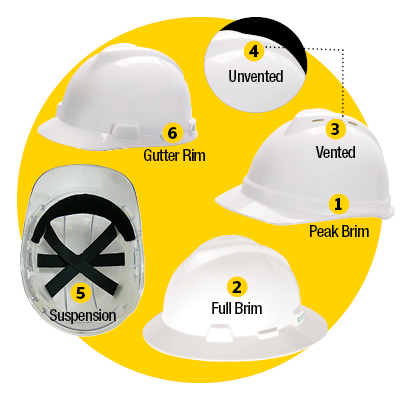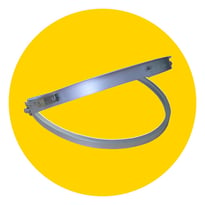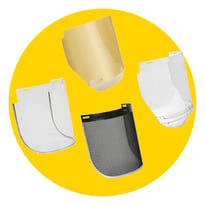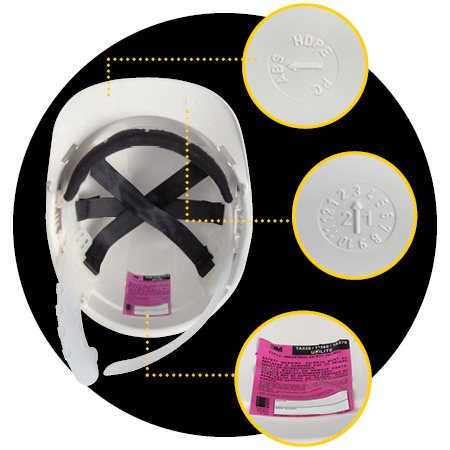Head protection is essential at any workplace where there is a risk of head injury. All unprotected head knocks can cause trauma to the brain and may result in serious health problems, including cognitive issues, memory loss, sleep disorders, inability to concentrate, permanent disability or death.
The risk of head injury can come from a wide range of hazards, including but not limited to:
- Falling objects from above
- Moving debris or other unintentional projectiles
- Minimal headroom causes a head knock on a fixed object
- Falls, trips and slips
It's important to select the appropriate head protection for your environment and to ensure a correct fit. Ill-fitting head protection can negate the intended and required benefits, and possibly create a greater risk.
Why Should I Wear a Hard Hat?
Hard hats are essential personal protective equipment (PPE) that protects workers from serious injury and even death from falling objects on a worksite. There are three different hard hat classifications that should be considered when selecting head protection for your workplace.
| Classification | Shell Material | Features |
| Type 1 | ABS Plastic | The most commonly used hard hats as they are suitable for general industrial, construction and mining applications. |
| Type 2 | High Temp Resistant Polycarbonate | Hard hats are intended for hot workplaces such as smelting and furnaces. |
| Type 3 | High Temp Resistant Polycarbonate | Hard hats are designed to withstand extreme heat conditions, including bush firefighting situations. They must have fluorescent and reflective markings and a chin strap no less than 15mm wide. |

 |
How to Correctly Fit a Hard HatHard hats need to be correctly fitted to the wearer to ensure adequate protection. This requires a secure, stable fit with no compromise on comfort; workers are often required to wear head protection for long periods of time, so maximising comfort is crucial. Things to consider when fitting a hard hat include:
|
Hard Hat Styles/Features
| Style | Description | Suitable Type |
| Baseball cap style with a front brim. Features side slits on the hard hat for the easy attachment of additional PPE. | 1 & 2 | |
| Brim continues around the entire hard hat. Provides additional protection from sun and light debris. Not always compatible with additional PPE. | 1, 2 & 3 | |
| Air release vents are designed to prevent overheating. There is usually a choice between six or nine vents. | 1 & 2 | |
| A closed hard hat casing prevents airborne particles from entering the helmet. | 1, 2 & 3 | |
| Internal suspension system to help absorb any impact on the outer shell. The higher the number of connection points, the more spread out the impact will be. Usually a choice between six and nine points. | 1, 2 & 3 | |
| Allows for rain and contaminants to run off safely and reduces the volume that falls on the worker's neck. | 1, 2 & 3 |
Complete Your Head Protection Set

Step 1 |

Step 2 |

Step 3 |
Hard Hat Inspection, Care and Maintenance
To maintain the highest level of worker safety, it is recommended that hard hats and other PPE are inspected regularly. This is to ensure any faults, defects or wear and tear are detected early and the product can be fixed or replaced.
The material of your hard hat will naturally age, so with general use, the Australian and New Zealand STandards advise that any safety helmet should be replaced every 3 years from the date of issue, and the suspension harness every 2 years. Any harsh work conditions or rough handling of the hard hat could mean these need to be replaced sooner.
Inspection Labels & MarkingsAll hard hats come with a sticker inside on which the wearer should record their name and date of issue. The hard hat should be removed from use no later than 3 years from that date, or earlier if required. A visual inspection should be carried out before each use, looking for signs that your hard hat might need replacing. These signs may include a change of colour, marks or damage or deterioration. If the sticker is missing, damaged or not filled in, then refer to the marking stamps under the brim of the hard hat. One stamp identifies the date of manufacture with the year in the middle of the circle and an arrow pointing to the month. This data can be used as a guide for when to replace your hard hat. The second stamp identifies what material the hard hat is made of. Storage, Cleaning and MaintenanceIt is important to store your hard hat correctly when not in use as there are many environmental and other factors that can compromise its integrity. Store your hard hat in a cool, dry place away from direct heat or sunlight. Also keep it away from chemicals, as the shell can be weakened by exposure to paints, thinners, and certain adhesives and cleaning products. Some of these chemicals can also reduce the electrical resistance of a hard hat. For any customising stickers and decals, ensure they use a non-solvent-based adhesive. Clean your hard hat with warm soapy water and avoid any harsh solvents or cleaning chemicals. Wash the suspension harness separately. |
 |
 |
Bump CapsBump caps are a form of head protection that is designed to protect against impact with stationary objects. This differs from hard hats or safety helmets, which offer protection against falling objects. Bump caps should only be used when there is no risk of impact from a falling object. Bump caps are commonly used in work environments where the likelihood of a worker striking their head against a stationary object is high, such as working in confined spaces. Safety Standards EN 812:2012 stipulates physical and performance requirements, methods of test and marking requirements for industrial bump caps. |
With a wide range of head protection options available it is sometimes difficult to decide on which one is right for you and/or your workplace. For further information head protection, contact the team at ATOM Safety.
